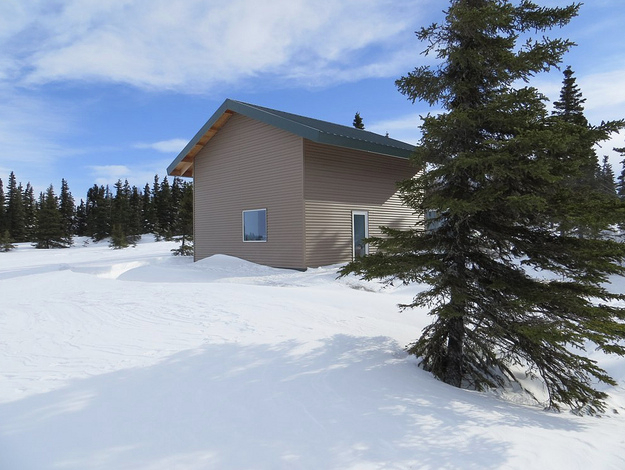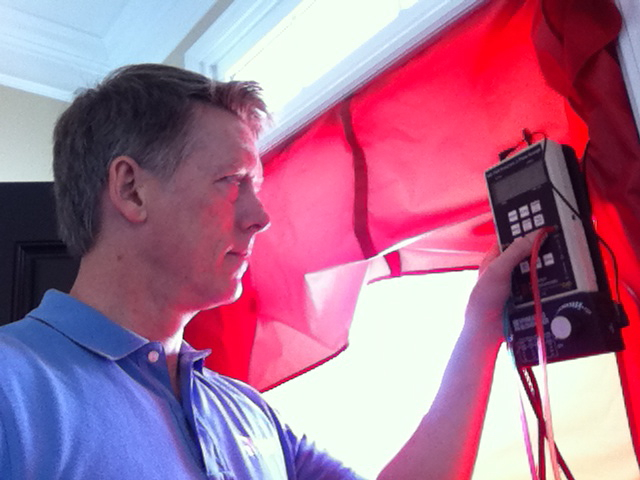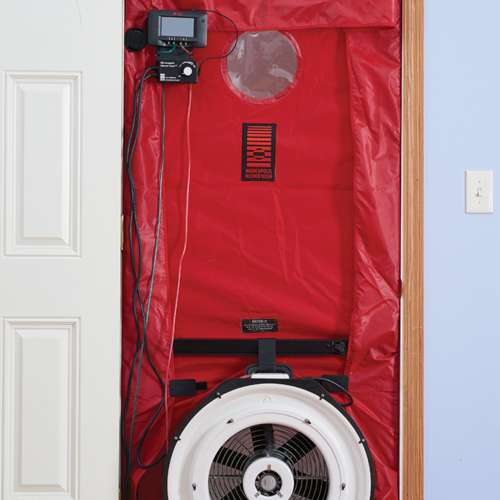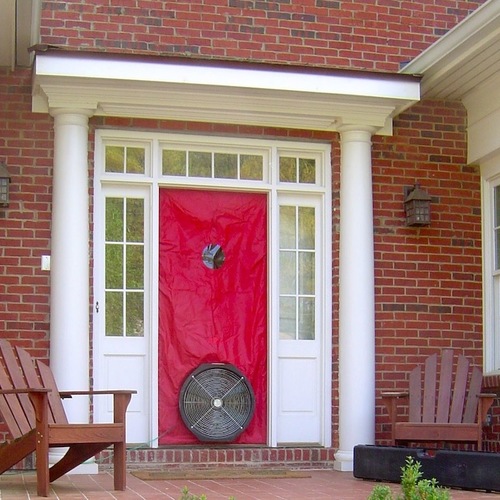Image Credit: Tom Marsik
Image Credit: Tom Marsik It only has three windows and a glass door for natural light, but high ceilings and bright interior paint keep the house interior from feeling gloomy.
Image Credit: Tom Marsik 'Box in a box' is how owner/builder Tom Marsik describes the construction of his superinsulated Alaskan home.
Image Credit: Tom Marsik
A Dillingham, Alaska, couple has claimed a world record for airtightness in a 600-sq. ft. home with 28-in. thick walls and a ceiling rated at R-140.
According to the World Record Academy, a blower-door test measured 0.05 air changes per hour at 50 pascals of pressure (ACH50), less than 10% of the very rigorous Passivhaus air-tightness standard of 0.60 ACH50.
The owners are Dr. Tom Marsik, an assistant professor of sustainable energy at the University of Alaska at Fairbanks’ Bristol Bay Campus, and his wife Kristin Donaldson.
The blower-door test was performed on March 6. Witnesses included Dillingham Mayor Alice Ruby and an analyst with the Building Performance Institute who called the results “phenomenally low.”
Weekly Newsletter
Get building science and energy efficiency advice, plus special offers, in your inbox.
Efficiency on a very small scale
The two-bedroom, one-bath house is insulated mostly with cellulose and is designed to be comfortable without a conventional heat source. Most of the heat comes from lighting, appliances, body heat and solar gain. The house needs the equivalent of 35 gal. of heating oil a year.
“If society acknowledges the importance of reducing energy consumption, a logical question to ask is: What good does it do to increase the energy efficiency of homes if it is outweighed by escalations in their size?” Marsik wrote in a description of the project in Alaska Building Science News. “The main purpose of this project is to demonstrate that by combining super-efficient construction technology with small house size, an extremely low energy home can be achieved.”
Marsik said the house was built with a “double-frame technique” that included a continuous vapor barrier and both cellulose and fiberglass insulation. “The basic idea is simple,” he wrote. “Build a small box inside a bigger box, seal the small box in a plastic bag, fill the whole cavity between the boxes with insulation, and you will end up with a supertight and superinsulated structure.
Other building features included:
- A heat recovery ventilator
- Triple-pane, argon-filled windows with fiberglass frames.
- Energy Star appliances and compact fluorescent lighting.
- Low-flow plumbing fixtures.
- All-electric operating, with no oil, propane or wood fuel.
Marsik says the extra insulation in the house cost $20,000, but he and his wife will see more than $4,000 in annual savings based on current energy costs. Total construction costs were $169,500.
















14 Comments
Minimalist
Spartan, but spiffy.
More than $280 per sq ft
and you can put the whole thing in my kitchen&living room. How much do they pay for energy that they can save $4000 on costs on a 600 sq ft home? I don't live in Alaska but I am in a zone that requires slightly more heating than cooling days and my entire energy bill (heating, cooling, hot water and all other energy uses) is only $4800 for a year in home that is SIX times the sq footage of this (and we have 8 people in the family taking baths everyday/ generating 8 - 10 loads of laundry every week)
Response to But Why
First of all, construction in Alaska costs more than in the lower 48.
Second, the house has triple-glazed windows with fiberglass frames.
Third, this is a house-within-a-house. Did you see the reported R-values?
Fourth, you spend $4,800 a year on energy? Ouch!
Heating in AK
Almost all non-wood heating in AK is done by resistance electricity or heating oil at a per-unit cost some multiplier of lower-48 average pricing. It's too cold to use heat pumps, and the natural gas grid isn't huge. Dillingham may have a comparatively temperate +15F mid-winter mean temp compared to the interior, but it's 99% outside design temp is in the -25F range and the heating season is 12 months long (yup, all year long, save a random handful of summer days!), with something on the order of 10-12,000 heating degree-days. At $5/gallon heating oil and a heating season like that it really adds up!
http://weatherspark.com/#!dashboard;a=AK/Dillingham
http://www.wrcc.dri.edu/cgi-bin/cliMONthdd.pl?ak2457
Seriously, " only " $4800 in annual energy bills? For a 3600' /8-person occupancy house, in roughly heating/cooling balanced climate- what's with that? It sounds like maybe a propane-heated 1978 code-min tract house in Macon GA (~2300HDD to ~2100 CDD) with a LOT of window area? An energy bill that big has a serious efficiency-upgrade budget to work with, and it's highly likely that it can be cut substantially with cost effective measures! (eg: If you have 8 people taking daily showers, a drainwater heat recovery heat exchangers would pay off in very short years. Air sealing & duct sealing will usually pay off in very short years too. I'm sure there are other higher-cost retrofits with longer term but still cost effective efficiency upgrades that can be taken too- houses are never really "done".)
My point of reference is my 2400' (+ 1500' semi conditioned basement ) sub-code 1923 antique, paying ~18cents/kwh and ~$1.15/therm gas, in a climate with about 6900HDD/350CDD, and my energy bills are less than half that. The occupancy is only 3 persons, true, but even adding for the extra cooling & bathing of 5 more sweaty bodies I couldn't come close to those kinds of numbers without leaving some windows open. We may be paying more per person, but since most of it is heating & lighting, the marginal costs per person or the slight uptick in fully conditioned floor area wouldn't make THAT much difference. (If I fully heated & cooled the insulated but not actively heated basement it would only add another ~$100 to the bill, if that.)
Which HRV did they use?
Does anybody know which HRV they used?
Dillingham has an average of
Dillingham has an average of about 11,333 HDD's. With heating oil likely over $6 or $7 per gallon and not to mention electric costs at likely $0.20 KWH - one can get to $4000 pretty quick in rural AK with a "normal" house.
I had the pleasure of doing a little work on this house a few years back when they were building it - Tom and Kristin put this thing together with the detail of a surgeon; as it shows in the blower door test.
Not sure what HRV they used; but Tom is the HRV guru and I am sure one of them will pop in and let you know.
Total cost I am sure does not include transportation costs which is another story in rural AK.
2 for 1
So if we all follow suit, we'd need to build two houses each time we want to build one. That certainly takes the sustainability discussion in a different direction.
Other than
the foundation, roof, siding, doors and windows, interior finishes, flooring, appliances, fixtures, drywall, mechanicals, painting - you're right, Mike.
Sorry
Should have said, frame two houses.
If this methodology takes off, I guess I should invest in lumber futures. Chop, baby, chop!
Congratulations to all
Congratulations to all involved! Ive always wondered who, where and what could make the claim.
As for the 600 sqft, is that interior dimensions? An exterior footprint of that size might see close to 200 sq ft disappear with walls that thick.
no time for aesthetics
So, all this time and energy spent to make the building energy efficient and zero time spent to make it visually appealing? The appearance of a building also contributes to its longevity; how many homely buildings do we see still standing in this country? The next owner may consider it ugly and just tear it down without taking a moment to consider its energy efficiency. Hire a designer to help.
By the way "But Why", OMG, sounds like your family needs a lesson in reducing consumption.
great
Great achievement, but the cost is a little high and I don't mean dollars. With all respect, from the one interior photo you'll never catch me living my life in a place like that. As we know, esthetics and ambience are extremely important for humans. A few more photos of the interior would be helpful but I doubt they'll dispel the feeling of confinement.
A home only a building scientist could love
Fascinating experiment for the minimalist in me but I could never live in a home like this year round.
Not surprising that the lights are consudered a heat source as they are going to be used a lot with only three windows.
I get the feeling this project was more about a world record envelope than building a home that adds value to the GB community.
Perhaps it's the way the price is written.
Maybe I just don't get it; but for me, this home is definitely NOT where the heart is.
Response to Todd, Marc, and Christopher
Todd, Marc, and Christopher,
It's an Alaska thing. I get it.
When the sun barely rises above the horizon for a few months every winter, and when the temperature outdoors is -50 degrees F, and when heating oil costs $5 a gallon, a house like this starts to look very much like a haven and a home.
Log in or create an account to post a comment.
Sign up Log in